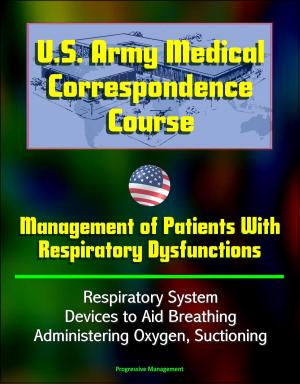U.S. Army Medical Correspondence Course: Food Deterioration - Detection, Major Causes, Meat, Seafood, Dairy Products, Eggs, Milk, Fruits and Vegetables, Health Hazards
Nonfiction, Food & Drink, Professional| Author: | Progressive Management | ISBN: | 9781310611681 |
| Publisher: | Progressive Management | Publication: | October 18, 2014 |
| Imprint: | Smashwords Edition | Language: | English |
| Author: | Progressive Management |
| ISBN: | 9781310611681 |
| Publisher: | Progressive Management |
| Publication: | October 18, 2014 |
| Imprint: | Smashwords Edition |
| Language: | English |
Foods undergo deterioration of varying degrees in their sensory characteristics, nutritional value, safety, and aesthetic appeal. Most foods, from the time they are harvested, slaughtered, or manufactured, undergo progressive deterioration that, depending upon the food, may be very slow or so rapid as to render the food virtually useless in a matter of hours. This presents a problem to the Department of Defense because food supplies have to be purchased well in advance of anticipated usage. Large quantities of food are lost each year due to deterioration. The problem is due to the perishable nature of food, as well as to the rather lengthy Defense subsistence supply chain. Due to these factors, veterinary food inspection specialists are tasked with recognizing deterioration in subsistence and making recommendations to preclude public health problems and financial losses to the Government.
CHAPTER 1 - INTRODUCTION TO FOOD DETERIORATION * Section I. General * Section II. Detection of Deterioration * Section III. Major Causes of Food Deterioration * Section IV. Deteriorative Conditions * Section V. Disposition Recommendations * Exercises * CHAPTER 2 - DETERIORATION OF MEAT AND MEAT PRODUCTS * Section I. Deteriorative Conditions in Meat and Meat Products * Section II. Determination of Potential Health Hazards, Recommendations, and References * Exercises * CHAPTER 3 - DETERIORATION OF WATERFOODS * Section I. Deteriorative Conditions in Waterfoods * Section II. Determination of Potential Health Hazards and Recommendations * Exercises * CHAPTER 4 - DETERIORATION OF DAIRY PRODUCTS AND SHELL EGGS * Section I. Causes of Off-Flavors in Milk * Section II. Deteriorative Conditions in Dairy Products * Section III. Determination of Potential Health Hazards in Dairy Products * Section IV. Deteriorative Conditions in Shell Eggs * Section V. Recommendations Regarding Deterioration of Dairy Products and Shell Eggs * Exercises * CHAPTER 5 - DETERIORATION OF FRESH FRUITS AND VEGETABLES * Section I. Deteriorative Conditions in Fresh Fruits and Vegetables * Section II. Determination of Potential Health Hazards, Recommendations, and References * Exercises * CHAPTER 6 - DETERIORATION OF SEMIPERISHABLE SUBSISTENCE * Section I. Deteriorative Conditions in Semiperishable Subsistence * Section II. Determination of Potential Health Hazards, Recommendations, and References
The Department of Defense (DOD) is concerned about the quality of the foods it procures, transports, stores, and issues. This concern is not unfounded. Of the large quantities being handled, a substantial amount of food has to be disposed of, or special action is taken in order to maintain quality and wholesomeness standards.
It is clear that all foods are perishable, regardless of the classification one may have seen for a particular food item. Some foods become unfit for human consumption more quickly than others. Foods are quite unlike hardware such as nuts and bolts. Yet, modern food markets and commissaries with their processed and preserved foods tend to give their customers the impression of similar durability for many food items. This is where the problem begins.
Food, from the time it is harvested, slaughtered, or processed, is continually undergoing deterioration. This presents a problem to DOD because food supplies have to be purchased well in advance of anticipated usage. Large quantities of food are lost each year due to deterioration. The problem is caused by the perishable nature of food as well as to the length of the supply chain. Because of these factors, veterinary food inspection specialists are tasked with recognizing deterioration in subsistence and making recommendations to preclude public health problems and financial losses to the government.
Foods undergo deterioration of varying degrees in their sensory characteristics, nutritional value, safety, and aesthetic appeal. Most foods, from the time they are harvested, slaughtered, or manufactured, undergo progressive deterioration that, depending upon the food, may be very slow or so rapid as to render the food virtually useless in a matter of hours. This presents a problem to the Department of Defense because food supplies have to be purchased well in advance of anticipated usage. Large quantities of food are lost each year due to deterioration. The problem is due to the perishable nature of food, as well as to the rather lengthy Defense subsistence supply chain. Due to these factors, veterinary food inspection specialists are tasked with recognizing deterioration in subsistence and making recommendations to preclude public health problems and financial losses to the Government.
CHAPTER 1 - INTRODUCTION TO FOOD DETERIORATION * Section I. General * Section II. Detection of Deterioration * Section III. Major Causes of Food Deterioration * Section IV. Deteriorative Conditions * Section V. Disposition Recommendations * Exercises * CHAPTER 2 - DETERIORATION OF MEAT AND MEAT PRODUCTS * Section I. Deteriorative Conditions in Meat and Meat Products * Section II. Determination of Potential Health Hazards, Recommendations, and References * Exercises * CHAPTER 3 - DETERIORATION OF WATERFOODS * Section I. Deteriorative Conditions in Waterfoods * Section II. Determination of Potential Health Hazards and Recommendations * Exercises * CHAPTER 4 - DETERIORATION OF DAIRY PRODUCTS AND SHELL EGGS * Section I. Causes of Off-Flavors in Milk * Section II. Deteriorative Conditions in Dairy Products * Section III. Determination of Potential Health Hazards in Dairy Products * Section IV. Deteriorative Conditions in Shell Eggs * Section V. Recommendations Regarding Deterioration of Dairy Products and Shell Eggs * Exercises * CHAPTER 5 - DETERIORATION OF FRESH FRUITS AND VEGETABLES * Section I. Deteriorative Conditions in Fresh Fruits and Vegetables * Section II. Determination of Potential Health Hazards, Recommendations, and References * Exercises * CHAPTER 6 - DETERIORATION OF SEMIPERISHABLE SUBSISTENCE * Section I. Deteriorative Conditions in Semiperishable Subsistence * Section II. Determination of Potential Health Hazards, Recommendations, and References
The Department of Defense (DOD) is concerned about the quality of the foods it procures, transports, stores, and issues. This concern is not unfounded. Of the large quantities being handled, a substantial amount of food has to be disposed of, or special action is taken in order to maintain quality and wholesomeness standards.
It is clear that all foods are perishable, regardless of the classification one may have seen for a particular food item. Some foods become unfit for human consumption more quickly than others. Foods are quite unlike hardware such as nuts and bolts. Yet, modern food markets and commissaries with their processed and preserved foods tend to give their customers the impression of similar durability for many food items. This is where the problem begins.
Food, from the time it is harvested, slaughtered, or processed, is continually undergoing deterioration. This presents a problem to DOD because food supplies have to be purchased well in advance of anticipated usage. Large quantities of food are lost each year due to deterioration. The problem is caused by the perishable nature of food as well as to the length of the supply chain. Because of these factors, veterinary food inspection specialists are tasked with recognizing deterioration in subsistence and making recommendations to preclude public health problems and financial losses to the government.















